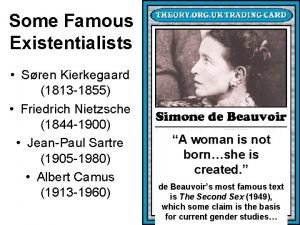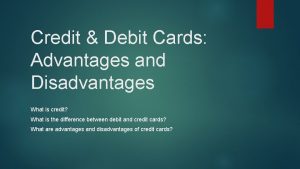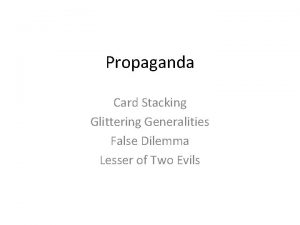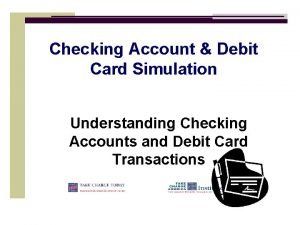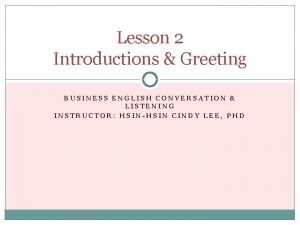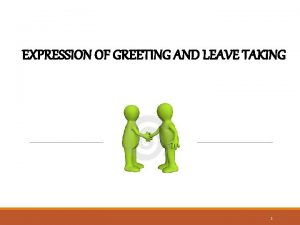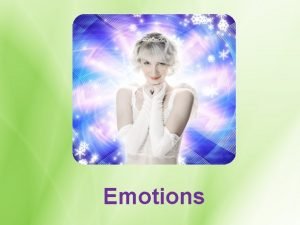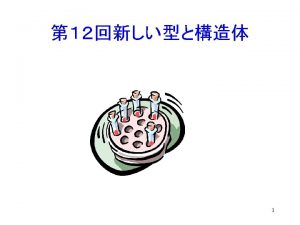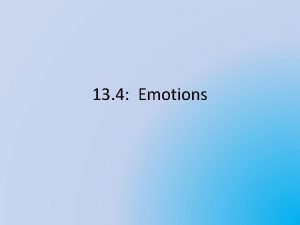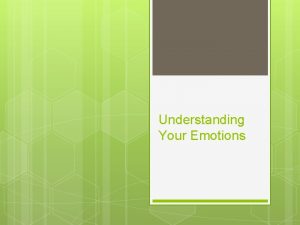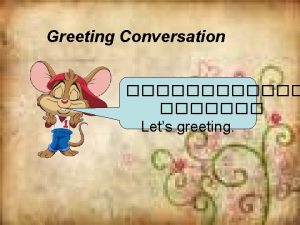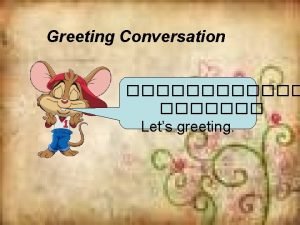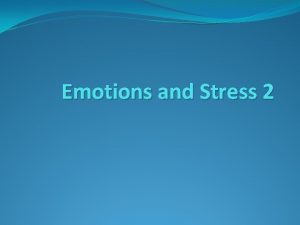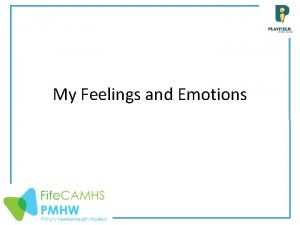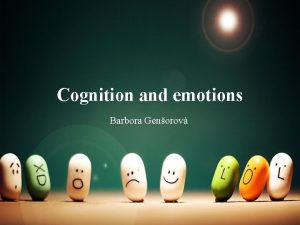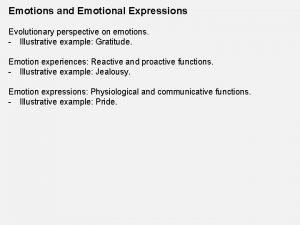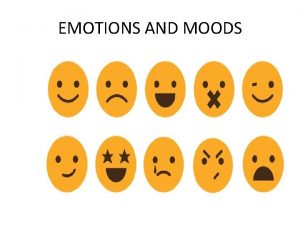EMOTIONS AND DEVELOPMENT The Existentialists Greeting Card Are

























- Slides: 25

EMOTIONS AND DEVELOPMENT

The Existentialists' Greeting Card Are we ever able to understand another person? Are others able to understand us? Can we ever know ourselves? Are humans basically alone?

What Emotion Is Best Described By Someone Who: 1. Totally understands how you feel in a wide variety of situations. 2. Knows what to say and how to act when you're sad, angry, happy. 3. Knows who you are, deep down. 4. Knows how to be with you, without saying much. Emotion? Love 5. You can count on to be these ways, day in/day out.

What Social Psych Phenomena is Implicated by These Actions? 1. Totally understands how you feel in a wide variety of situations. 2. Knows what to say and how to act when you're sad, angry, happy, etc. 3. Knows who you are, deep down. 4. Knows how to be with you, without saying much. Phenomena The 5. You can count on to be these ways to you, day in/day out. ? Self Today’s class: The role of early social bonds, emotional attunement, and development of the self.

Emotional Development Video Spitz foundling home study Emotional dance between mom’s and babies "Non-responsive” mom drama a. What happens in this sequence? b. How does it feel to watch it? Temperament and mom/child interaction Early empathy and socialization Self-contingent emotions: Embarrassment Emotional signaling: Visual cliff and

Affect Attunement Process that occurs between parent and infant which allows an infant to perceive how it is perceived. 1. Requires that parent is able to read the infant’s emotional state / inner experience from over behavior. 2. Infant must be able to interpret parents’

Examples of Attunement 1. Baby excited by toy, grabs it, lets out an “aaaahhh!!!” Mom does intense go-go dancer shimmy, lasts as long as baby’s “aaaahhh”. 2. Baby boy hits things with plastic hammer, in steady rhythm. At each stroke, mom goes “kaaaboom! kaaa-boom! Kaaa-boom!” in cadence with hammer strikes. 3. Baby reaches for toy just beyond reach. As it pushes towards toy, mom goes “uuh, …. uuuuh!, --uuuuhhh!!!” with his efforts.

What Are Attunements? Attunement is not simply imitation. Not mirroring, not echoing. Cross modal: channel used by mom different from that used by baby Reference for match is internal state, not simply external behavior. Nature of match is itself an expression of inner state that corresponds to inner state expressed by baby Process is rapid and largely unconscious

Attunement Study Design * 10 moms, 5 w’ baby girls, 5 w’ baby boys * Moms told to bring baby and two of baby’s favorite toys * Moms told to play with baby as normally do * Interactions videotaped, moms help score “events” * Event is: 1. Any time baby showed marked change in emotion 2. Mom behaved in way that looked like mirroring,

What Got Scored in Attunement Study Modality Match: voice, face, etc. Dimensions of Match: Intensity: Absolute level, directional shift Timing Matches: Beat, rhythm, duration Shape Matches: Contour (rise, fall, rise of voice, e. g. ) Mom’s awareness of her own behavior Type of Attunement: Overmatch, equal match, undermatch

Functions of Attunement 1. To be with (positive) 2. To be with (negative) FHV: Mom laughs at child's fear of own shadow 3. Responses: pos or neg reinforcement 4. Tuning: increase or decrease arousal level 5. Restructure interaction: change course of behavior 6. Play routine: Match part of an established play routine

Results of Attunement Study a. Frequency of attune: 1 every 65 seconds. b. Mode of attunements: Vocalizations Gestures Facial displays c. Types of attunements Mixed mode: d. Mom’s awareness Cross mode: Unaware: Same mode: Partly aware: 48% 39% 13% 38% 30% 31%

Functions of Attunements Acting With Acting Upon 1. Commune (be with) = 45% 2. Respond 33% = 3. Tune = 19% 4. Restructure = 02% 5. Play routine = 01%

Babies' Responses to Attunements Most common response from baby during attunement is: ___ smiling ___ cooing ___ playing X more Mom's told to "mis-attune" to baby. ___ no response Baby looks at mom as if saying "What gives? " Indicates baby feels like mom/baby are a single unit, needs to respond only if the "unit" fails.

Adult “Intersubjectivity” 1. Playing, flirting, connecting 2. Guy to Guy vs. Girl to Girl a. Guys? : b. Girls? : 2. Emotional support, understanding John Cassevettes, Gena Rolands: A Woman Under the Influence (1974) Rolands: Dad, aren’t you going to stand up for me? Dad: Stands up. Hanging out together

The Sense of a Core Self in Infancy Daniel Stern, The Interpersonal World of the Infant's first job is to form sense of core self and Infant, 1985 core others. 2 -3 mos. , says Stern, 1 yr. , others When does self begin to emerge? Stern’s approach sounds like what previous reading? Winnicott What are 4 critical elements of having a self, being a self? SENSE OF 1. Agency: Author of own actions 2. Coherence: Not fragmented, whole, congruent 3. Affectivity: Feelings that belong to own experiences

Early Parent/Child Interactions, and the Discovery of Invariants Motive to order one's universe (i. e. make meaning) is an imperative of mental life. Identifying "invariants", constants across situations, is critical to achieving this ordering. Parent/child play provides lessons in invariants a. Walking fingers game b. Mom leaning in to/pulling back from baby (in video, e. g. ) These games involve both repetition but also variation around theme.

Lessons in Parent/Baby Games What does baby learn in these games? 1. Central theme imbedded in variations gives sense of invariants; higher-order abstraction is constant, even if variations differ. Hey, honey. . . Yeah, honey. . . Hi, honey. . . Whatcha doing, honey? . . . Yeah, whatcha doing? . . What are ya doing? . . . what are ya doing there? . . . ya doing nothing? Exquisite repetition and variation: Bach: http: //www. youtube. com/watch? v=j. KSg 8 t 4 zy. Lg Ella: https: //www. youtube. com/watch? v=Pr. Vu 9 WKs 498 2. Self Regulation: Baby can pull back, reset. Capacity to use own intention to change inner state. 3. Agency: motor plans develop, and carry the “signature” of the self.

Goodnight Moon (A Story of Variation Around a Theme) Margaret Wise Brown Goodnight room Goodnight moon Goodnight cow jumping over the moon Goodnight light And the red balloon Goodnight bears Goodnight chairs Goodnight kittens And goodnight mittens

Repetition, Variation, and Transcendence: The Gettysburg Address Fourscore and seven years ago our fathers brought forth on this continent a new nation conceived in liberty and dedicated to the proposition that all men are created equal. Now we are engaged in a great civil war testing whether that nation, or any nation so conceived and so dedicated, can long endure. We are met on a great battlefield of that war. We have come to dedicate a portion of that field as a final restingplace for those who here gave their lives that nation might live. It is altogether fitting and proper that we should do this. But, in a larger sense, we cannot dedicate, we cannot consecrate, we cannot hallow this ground. The brave men living and dead, who struggled here have consecrated it far above our poor power to add or detract. The world will little note nor long remember what we say here, but it can never forget what they did here. It is for us the living rather to be dedicated here to the unfinished work which they who fought here have thus far so nobly advanced. It is rather for us to be here dedicated to the great task remaining before us — that from these honoured dead we take increased devotion to that cause for which they gave the last full measure of devotion — that we here highly resolve that these dead shall not have died in

Self Coherence What are the invariants (i. e. , the clues, properties) that signal that one’s self is a separate, coherent, whole? That the same is true of others? Unity of locus: The self is in only one place at any one time Coherence of motion: Things that move coherently in time belong together. Coherence of time: Self-synchrony. Different parts of body move together. (i. e. , try talking slow and moving fast). Coherence of form: Baby recognizes mom's face, even when mom is exhibiting different expressions. At 2 -3 mos, recognizes mom in partial photo. All suggest an

Self Affectivity Emotions are excellent higher-order self-invariants. Why? 1. Emotions are fixed by design, and remain constant throughout life. Sadness at 6 mos is much the same as sadness at 60 yrs. Recall faces of Spitz's foundling home infants. 2. Emotions provide three source of invariant info: a. Proprioceptive feedback b. Sensations of arousal and activation c. Qualities of feeling 3. How emotion provides invariant. What does baby feel when: Dad tosses in air, mom does tickle game, grandma makes funny faces? Are these same events? No. Is emotion

Self History Core self would not develop without memory of own experience. Do infants have enough memory for invariants to occur, and to be integrated? 1. Leg movements and mobile 2. Novel photos, time 1, time 2 3. Music heard in womb: Granier-Deferre C, et al. , (2011) 4. Dr. Seuss read during pregnancy (De. Kasper & Fifer, 1980)

Expectancies, Schemas and the Emergent Self Infants, like all humans, depend on episodic memory. Episodic memory is like movie clip; discrete beginning, middle, end. Meaningful chunks of experience. Infants extract invariants from episodes. They form schemas. Strauss (1979) show babies set of faces that all vary in terms of size, place of features. But these are variations of underlying "central face". When later given opportunity to "select" best picture of face, they pick an entirely novel photo that captures "average face".

Expectancies, Schemas and the Emergent Self Stern: Infants' ability to develop schemas applies to their own self. What is the common link, asks baby to him/herself, between: sense of agency; sense of coherence; sense of affect? Common link is sense of self. This sense of self is emergent property Occurs between 2 -7 mos. =
 Insidan region jh
Insidan region jh Famous existentialists
Famous existentialists How to write a card in german
How to write a card in german Advantages and disadvantages of debit card and credit card
Advantages and disadvantages of debit card and credit card Lesser of two evils propaganda
Lesser of two evils propaganda Debit card simulator
Debit card simulator Ladies and gentlemen presentation
Ladies and gentlemen presentation The greeting in this conversation is
The greeting in this conversation is Leave taking expressions in english
Leave taking expressions in english Greets and assists guests arriving at the hotel
Greets and assists guests arriving at the hotel Good afternoon responses
Good afternoon responses Dialog greeting and leave taking
Dialog greeting and leave taking Meeting and greeting etiquette
Meeting and greeting etiquette Meeting and greeting etiquette
Meeting and greeting etiquette Hát kết hợp bộ gõ cơ thể
Hát kết hợp bộ gõ cơ thể Lp html
Lp html Bổ thể
Bổ thể Tỉ lệ cơ thể trẻ em
Tỉ lệ cơ thể trẻ em Gấu đi như thế nào
Gấu đi như thế nào Chụp phim tư thế worms-breton
Chụp phim tư thế worms-breton Hát lên người ơi
Hát lên người ơi Các môn thể thao bắt đầu bằng tiếng nhảy
Các môn thể thao bắt đầu bằng tiếng nhảy Thế nào là hệ số cao nhất
Thế nào là hệ số cao nhất Các châu lục và đại dương trên thế giới
Các châu lục và đại dương trên thế giới Công thức tính thế năng
Công thức tính thế năng Trời xanh đây là của chúng ta thể thơ
Trời xanh đây là của chúng ta thể thơ

